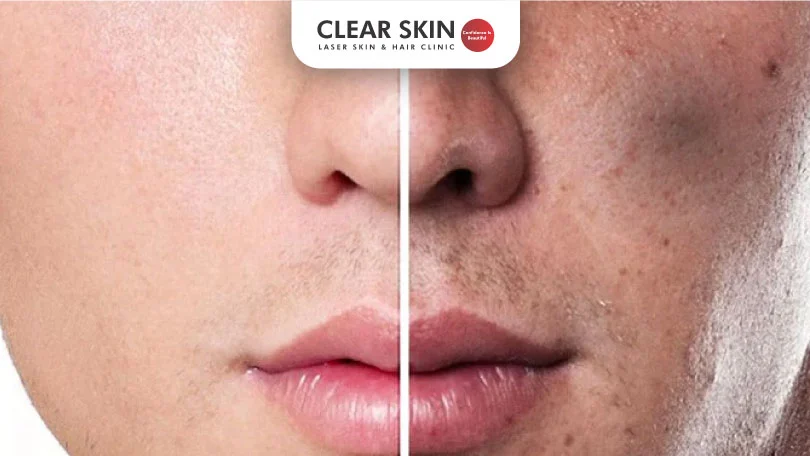What You Need to Know About Melasma in Men
Reviewed By: ![]() Dr. Dhanraj Chavan
Dr. Dhanraj Chavan
Updated on: 13th April, 2022

Are you tired of seeing dark, patchy pigmentation on your face that won’t go away? Have you tried covering up these stubborn patches with makeup or skincare products?
Well, you might be dealing with melasma – and contrary to popular belief, this condition is not just limited to women. In fact, men can also suffer from melasma, which can be caused by various factors such as genetics, hormones, and sun exposure.
In this article, we will explore everything you need to know about melasma in men, including its causes, symptoms, and the most effective treatment options available. So, if you are a man struggling with melasma or simply want to learn more about this condition, read on!
Table Of Content
- What is Melasma?
- Types of Melasma
- What Does Dermal Melasma Look Like?
- Causes of Melasma in Men
- Symptoms of Male Melasma
- Treatment for Melasma in Men
- How to Cope With Male Melasma?
- Conclusion
What is Melasma?
Melasma is a common skin condition that causes dark, patchy pigmentation on the face, typically on the cheeks, forehead, nose, upper lip, and chin. It occurs when there is an overproduction of melanin, the pigment responsible for skin colour.
Melasma in men can be a source of embarrassment and self-consciousness, as the patches can be difficult to cover up with makeup or skincare products.
While it is more commonly seen in women, men can also develop melasma, especially those with darker skin tones. Men must understand the condition and seek effective treatment options to manage melasma and improve their skin’s appearance.
Types of Melasma
It Melasma in men can be categorised into three main types based on its location and depth in the skin:
Epidermal Melasma
This type of melasma appears on the skin’s surface layer and is brown. It is the most common type of melasma and responds well to treatment.
Dermal Melasma
This type of melasma appears in the skin’s deeper layers and is bluish-grey. It can be more difficult to treat than epidermal melasma.
Mixed Melasma
This type of melasma appears in the skin’s epidermal and dermal layers and combines brown and bluish-grey colours. It can be the most challenging type of melasma to treat.
What Does Dermal Melasma Look Like?
Dermal melasma is a type of melasma that occurs deeper in the skin’s layers. It appears as grey or brown patches on the skin, and the pigmentation is usually more diffuse and less well-defined than in other types of melasma. Dermal melasma is often harder to treat than different types because it is deeper in the skin.
The patches of dermal melasma may be irregular in shape and vary in size. They are commonly found on the cheeks, forehead, and upper lip but can also appear on other face and body areas.
It’s important to note that the appearance of dermal melasma can vary from person to person, and it may be difficult to distinguish it from other skin conditions without a proper diagnosis from a dermatologist. If you notice any changes in your skin’s pigmentation, it’s important to consult with a healthcare professional for appropriate evaluation and treatment.
Causes of Melasma in Men
The causes of melasma in men are not fully understood, but several factors have been identified as potential triggers, including:
Sun Exposure
Exposure to ultraviolet (UV) light from the sun is a major contributor to the development of melasma. Men who spend much time outdoors without proper sun protection are more likely to develop melasma.
Hormonal Changes
Hormonal changes, such as during puberty or due to certain medications, can trigger melasma in men.
Genetics
Melasma can be inherited, and men with a family history of the condition are more likely to develop it themselves.
Skincare Products
Certain skincare products, such as those containing fragrances or essential oils, can trigger the development of melasma in men.
Age
Age alone does not cause melasma in men. However, as men age, their skin becomes more susceptible to damage from sun exposure and other environmental factors, which can trigger the development or worsening of melasma.
Medications
Certain medications, like hormonal medications, anti-seizure medications, antibiotics, anti-inflammatory drugs, and chemotherapy drugs, can make the skin more sensitive to sunlight and increase the risk of developing melasma.
Medical Conditions
People with a thyroid disease or adrenal gland disorder are more prone to melasma.
Symptoms of Male Melasma
Melasma in men, like in women, is characterised by brown or grey-brown patches on the skin, typically on the face. These patches can vary in size and shape and may appear on the forehead, cheeks, nose, and upper lip. Other symptoms of melasma in men can include:
- Brown or grey-brown patches on the face, especially on the forehead, cheeks, nose, and upper lip.
- The patches may have an irregular shape or appear blotchy, but have a well defined border
- The skin may also appear slightly raised or have a rough texture.
- The patches may darken with sun exposure and fade during the winter months.
- The affected area may sometimes have a slight itching or burning sensation.
Treatment for Melasma in Men
Melasma treatment for males is similar to that for women, and it involves a combination of topical creams, sun protection, and professional dermatological treatments. Here are some of the treatment options for male melasma:
Topical Medication
Prescription-strength creams containing hydroquinone, tretinoin, or corticosteroids can help reduce melasma’s appearance. These creams reduce the production of melanin, which is responsible for the dark patches on the skin. These creams should only be used under the supervision of a dermatologist.
Sun Protection
It is crucial to avoid sun exposure and use a broad-spectrum sunscreen with an SPF of 30 or higher when going out. Sun exposure can worsen melasma, so wearing a hat and protective clothing when outside is essential.
Chemical Peels
A chemical peel is a cosmetic procedure in which a chemical solution is applied to the skin, causing it to exfoliate and eventually peel off, revealing new, smoother skin underneath.
Chemical peels can help reduce melasma’s appearance by removing the top layer of skin that contains excess melanin pigment. The type of chemical peel used to treat melasma is usually a superficial peel, meaning it only affects the top layer of the skin.
Dermabrasion
Dermabrasion involves the removal of the top layers of the skin using a high-speed rotating brush or diamond wheel. While dermabrasion can treat various skin conditions, it is generally not recommended as a first-line treatment for male melasma.
Microdermabrasion
Microdermabrasion is a professional melasma treatment for males that uses a special device to exfoliate the top layer of the skin, revealing new, brighter skin underneath. This Microdermabrasion treatment can also be used for females.
Laser Treatment
In some cases, a Best dermatologist may recommend laser treatments to treat melasma. Laser therapy can effectively reduce melasma’s appearance by breaking up the melanin pigments in the skin.
How to Cope With Male Melasma?
Melasma can be distressing for anyone who experiences it, but there are ways to cope. Here are some tips to help you manage male melasma:
- See a dermatologist for an accurate diagnosis and appropriate treatment. They can recommend treatments and advise on how to prevent further damage to the skin.
- Melasma can be triggered or worsened by sun exposure, so protecting your skin from the sun’s harmful rays is important. This includes wearing broad-spectrum sunscreen with an SPF of 30 or higher, wearing a hat and protective clothing and avoiding sun exposure during peak hours.
- Proper skincare can help improve the appearance of symptoms of melasma. This includes using gentle cleansers and moisturisers and avoiding harsh products that can irritate the skin.
Conclusion
Melasma is a common skin condition that can affect both men and women. If you are experiencing dark patches on your skin, it’s important to seek professional help from a dermatologist who can diagnose and provide the appropriate treatment.
At Clear Skin Clinic in Pune, we offer a range of treatments for melasma in men and women, including topical creams, chemical peels, and laser therapy. Our experienced dermatologists can provide personalised advice and support to help you cope with the condition and achieve clear, healthy skin.
Book a consultation with Clear Skin Clinics today and take the first step towards clearer, brighter skin!
Do You Know?
Roughly 250 Patients Are Treated
Everyday By These Dermatologists
(You are one click away from flawless skin)
Meet Our Dermatologist!
Conclusion
In conclusion, dealing with dark knuckles involves identifying the underlying causes and applying effective treatments. Home remedies such as exfoliation with natural ingredients and specific blends like honey and lemon juice can help lighten dark patches. However, for persistent issues or underlying health conditions, consulting a dermatologist is essential. Professional treatments like topical retinoids, laser therapy, and microdermabrasion offer effective solutions for achieving even-toned skin. By combining these approaches, you can restore the natural beauty of your hands. For personalized advice, book a consultation with a dermatologist.
Further Reading
Is Tretinoin Cream Safe for Melasma? Tips and Usage Guide
Discover how tretinoin cream can safely treat melasma.
Unveiling the Potential of Face Packs for Acne Scars
Discover how homemade and customized face packs can help lighten acne marks and rejuvenate your skin.
Home Remedies for Acne Scars
Effective Home Remedies for Acne Scars
Salicylic Acid: Your Ultimate Guide to Banishing Acne Scars
Salicylic acid helps fade acne scars by exfoliating the skin and promoting cell renewal. Discover its benefits, effectiveness, and how to use it safely.
Have thoughts? Please let us know
We are committed not only to treating you, but also educating you.






